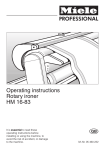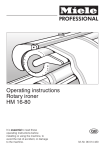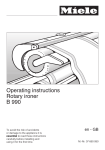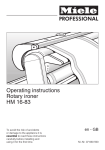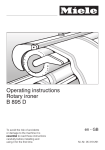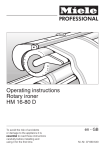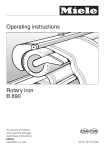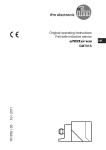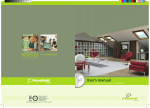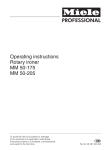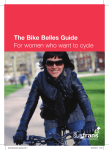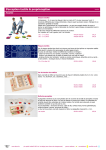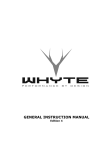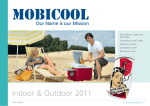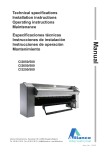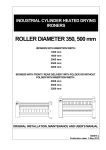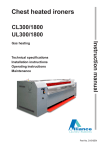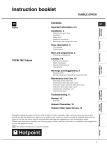Download Operating instructions Rotary ironer HM 16-83
Transcript
Operating instructions Rotary ironer HM 16-83 To avoid the risk of accidents or damage to the machine it is essential to read these instructions carefully before installing and using it for the first time. G M.-Nr. 05 460 232 Contents Description of the appliance . . . . . . . . . . . . . . . . . . . . . . . . . . . . . . . . . . . . . . . . 3 Warning and safety instructions . . . . . . . . . . . . . . . . . . . . . . . . . . . . . . . . . . . . . 4 Caring for the environment . . . . . . . . . . . . . . . . . . . . . . . . . . . . . . . . . . . . . . . . . . 6 Moving the appliance. . . . . . . . . . . . . . . . . . . . . . . . . . . . . . . . . . . . . . . . . . . . . . . 7 Preparation of the working area. . . . . . . . . . . . . . . . . . . . . . . . . . . . . . . . . . . . . . . . 7 Before using for the first time . . . . . . . . . . . . . . . . . . . . . . . . . . . . . . . . . . . . . . . 8 Dust cover . . . . . . . . . . . . . . . . . . . . . . . . . . . . . . . . . . . . . . . . . . . . . . . . . . . . . . . . 8 Before ironing. . . . . . . . . . . . . . . . . . . . . . . . . . . . . . . . . . . . . . . . . . . . . . . . . . . . . 9 Preparing the laundry . . . . . . . . . . . . . . . . . . . . . . . . . . . . . . . . . . . . . . . . . . . . . . . 9 More advice on correct dampness. . . . . . . . . . . . . . . . . . . . . . . . . . . . . . . . . . . 9 Pulling into shape and smoothing out . . . . . . . . . . . . . . . . . . . . . . . . . . . . . . . . 9 Sorting . . . . . . . . . . . . . . . . . . . . . . . . . . . . . . . . . . . . . . . . . . . . . . . . . . . . . . . . 9 Checking the effectiveness of the finger guard. . . . . . . . . . . . . . . . . . . . . . . . . . . 10 Ironing . . . . . . . . . . . . . . . . . . . . . . . . . . . . . . . . . . . . . . . . . . . . . . . . . . . . . . . . . 11 Switching on and off . . . . . . . . . . . . . . . . . . . . . . . . . . . . . . . . . . . . . . . . . . . . . 11 Selecting the ironing temperature. . . . . . . . . . . . . . . . . . . . . . . . . . . . . . . . . . . 11 Selecting the roller speed. . . . . . . . . . . . . . . . . . . . . . . . . . . . . . . . . . . . . . . . . 12 Positioning the laundry . . . . . . . . . . . . . . . . . . . . . . . . . . . . . . . . . . . . . . . . . . . . . 13 Laundry bar . . . . . . . . . . . . . . . . . . . . . . . . . . . . . . . . . . . . . . . . . . . . . . . . . . . 13 After ironing . . . . . . . . . . . . . . . . . . . . . . . . . . . . . . . . . . . . . . . . . . . . . . . . . . . . . . 14 Power cut . . . . . . . . . . . . . . . . . . . . . . . . . . . . . . . . . . . . . . . . . . . . . . . . . . . . . . . . 14 Points on ironing . . . . . . . . . . . . . . . . . . . . . . . . . . . . . . . . . . . . . . . . . . . . . . . . . 15 Maintenance and care . . . . . . . . . . . . . . . . . . . . . . . . . . . . . . . . . . . . . . . . . . . . . 17 Problem solving guide. . . . . . . . . . . . . . . . . . . . . . . . . . . . . . . . . . . . . . . . . . . . . 20 After sales service . . . . . . . . . . . . . . . . . . . . . . . . . . . . . . . . . . . . . . . . . . . . . . . . 21 Electrical connection . . . . . . . . . . . . . . . . . . . . . . . . . . . . . . . . . . . . . . . . . . . . . . 22 Electrical connection U.K. . . . . . . . . . . . . . . . . . . . . . . . . . . . . . . . . . . . . . . . . . . . 22 Electrical connection AUS / NZ . . . . . . . . . . . . . . . . . . . . . . . . . . . . . . . . . . . . . . . 23 Technical data . . . . . . . . . . . . . . . . . . . . . . . . . . . . . . . . . . . . . . . . . . . . . . . . . . . 24 2 Description of the appliance Temperature selector Emergency release Finger guard plate Heater plate Roller Feed board Bar for hanging ironed laundry Ironing table Mains connection cable Foot pedal switch Control panel Indicator light "oC Temperature" Roller speed selector "I On - 0 Off" button for switching the ironer on and off 3 Warning and safety instructions To avoid the risk of accidents or damage to the appliance it is essential to read these instructions carefully before installing and using it for the first time. They contain important information on its safety, use and maintenance. Keep these instructions in a safe place for reference, and pass them on to any future user. Appropriate use This rotary ironer is intended exclusively for ironing textiles which are suitable for machine ironing and which have been washed in water. Technical and electrical safety Before setting up the appliance, check it for any externally visible damage. Do not install and use a damaged appliance. A damaged appliance is dangerous. Switch off at the mains and call the Service Department for assistance. Before connecting the appliance, ensure that the connection data on the data plate (fusing, voltage and frequency) match the mains electricity supply. If in any doubt, consult a qualified electrician. The electrical safety of this appliance can only be guaranteed when continuity is complete between the appliance and an effective earthing system which complies with local and national safety regulations. 4 It is most important that this basic safety requirement is regularly tested by a qualified electrician. The manufacturer cannot be held responsible for the consequences of an inadequate earthing system. The appliance is built in accordance with current safety requirements. Unauthorised repairs could result in unforeseen dangers for the user, for which the manufacturer cannot accept responsibility. Repairs should only be undertaken by a Miele approved engineer. Ensure current is not supplied to the appliance while maintenance or repair work is being carried out. Faulty components must only be exchanged for Miele original spare parts. Only when these parts are fitted can the safety standards of the appliance be guaranteed. The appliance is only completely isolated from the electricity supply when: – it is switched off at the wall socket and the plug is withdrawn, or – it is switched off at the mains, or – the mains fuse is withdrawn. Warning and safety instructions Do not damage, remove or bypass the safety components or control elements on the appliance. Only operate the rotary ironer when all removable outer casings are fitted so that it is not possible to touch any electrical component or moving part. This equipment may only be used in mobile installations such as ships, caravans, aircraft etc. if a risk assessment of the installation has been carried out by a suitably qualified engineer. Use When the ironer is heated up there is an acute danger of burning: – if the heater plate is touched – if the foot pedal is pressed down while fingers or hands are positioned between the raised roller and the heater plate to smooth an article. Never drape items over the heater plate when it is heated up. This is a fire hazard. Do not lay the connection cable over the heater plate when it is heated up. This could damage the cable - danger of electric shock. Use the cable holders attached to the appliance to wind the cable away. In countries where there are areas which may be subject to infestation by cockroaches or other vermin, pay particular attention to keeping the appliance and its surroundings in a clean condition at all times. Any damage which may be caused by cockroaches or other vermin will not be covered by the appliance guarantee. This appliance is not a toy! To avoid the risk of injury do not allow children to play on or near it or to play with the controls. Supervise its use by the elderly or infirm, and supervise children whilst you are using it. Accessories Accessory parts may only be fitted when expressly approved by Miele. If other parts are used, guarantee, performance and product liability claims may be invalidated. Hang laundry on the swing out bar. Swing it back immediately after use. Take care not to press down on the bar when it is swung out. There is a danger that this could tip the ironer over. Switch the appliance off before removing the plug from the electricity socket. 5 Caring for the environment Disposal of the packing material Disposal of your old appliance or machine The transport and protective packing has been selected from materials which are environmentally friendly for disposal and can normally be recycled. Electrical and electronic appliances / machines often contain materials which, if handled or disposed of incorrectly, could be potentially hazardous to human health and to the environment. They are, however, essential for the correct functioning of your appliance or machine. Please do not therefore dispose of your old machine or appliance with your household waste. Rather than just throwing these materials away, please ensure they are offered for recycling. Ensure that any plastic wrappings, bags etc. are disposed of safely and kept out of the reach of babies and young children. Danger of suffocation! Please dispose of it at your local community waste collection / recycling centre and ensure that it presents no danger to children while being stored for disposal. It should be unplugged or disconnected from the mains electricity supply by a competent person. The plug must be rendered useless and the cable cut off directly behind it to prevent misuse. See the "Warning and Safety" section of this booklet for further details. 6 Moving the appliance Moving the appliance The rotary ironer is fitted with four rollers. ^ Hold the ironer by the ironing table and push or pull to move it. Preparation of the working area A height-adjustable chair is useful and also a flat surface, e.g. a table, to lay the ironed laundry on. To overcome obstacles such as carpet edges and doorways but also to steer: ^ Tilt the appliance slightly. Make sure the ironer is level and secure and that it cannot roll sideways. Place close at hand: – a basket with the laundry ready for ironing to the left of the rotary ironer, – a surface for the ironed laundry to the right of the rotary ironer. Shirts, overalls and blouses etc., should be hung on coathangers immediately after ironing. Small items can be hung over the swing out bar. Have some water ready for redamping the laundry if necessary. 7 Before using for the first time Dust cover The dust cover which protects the roller during transit has to be removed. Then plug the appliance in and switch it on. The heater plate will then rise automatically. Connection cable The mains connection cable is wound round a hook underneath the ironing table. ^ Unwind the cable. Do not insert the plug into the electrical socket yet. N.B. The plug shown is for illustration only. 8 Before ironing Preparing the laundry Correct preparation of the laundry is essential for successful ironing. Before ironing, the laundry should be: Pulling into shape and smoothing out Pull the dampened laundry into shape as usual. Smooth out ribbons, straps, seams and hems. – damped down – pulled into shape and smoothed out – sorted Damping down The laundry needs to be sufficiently damp, so that when it is passed just once through the rotary ironer at the correct temperature, it will come out smooth and dry. Dampen the laundry as you would for hand ironing, preferably several hours beforehand so that the articles achieve a uniform degree of dampness throughout. If a tumble dryer is being used, select a "Machine iron" programme. Use warm water if preparation time is short and also to redampen. More advice on correct dampness Material Dampness for ironing Silk wrap in a damp cloth to avoid water marks Synthetics e.g. Dralon, Nylon, Polyester etc. slightly damp to dry Wool (e.g. trousers) press under a damp cloth Cotton slightly damp Linen quite damp Large items such as table cloths, bed linen etc should be folded lengthways into a number of pleats so that they can be ironed as easily as possible. Sorting Sort the laundry according to how much heat is required for ironing. This way you can start by ironing at a lower temperature and then gradually increase the temperature according to the fabric being ironed. First iron synthetic fibres such as nylon, polyester and artificial silk which only require a low temperature. Then iron silk, wool, cotton and linen at increasing temperatures. Iron starched items last of all to avoid any starch deposits from affecting the finish of other items. 9 Before ironing Checking the effectiveness of the finger guard Before using the ironer for the first time: The finger guard is a safety feature and should be checked each time before the ironer is used. When the ironer is new, you may experience difficulty at first when feeding in delicate items of laundry. This will become easier after the ironer has been operating for between 5 - 10 minutes. Laundry will pass smoothly over a new ironer cover after it has been washed at a temperature of 60°C. ^ With the ironer switched on, press the foot pedal right down. – the heater plate comes down onto the rotating roller. ^ If you now lift the finger guard, the roller stops rotating and the heater plate rises up. This shows that the finger guard is working. ^ Let go of the finger guard and remove your foot from the foot pedal. ^ Press the foot pedal right down agan. – the heater plate lowers and the roller rotates. 10 Ironing Material Dot symbol Polyester / artificial silk Silk / Wool Cotton / Linen Temperature range cool iron (low temperature) medium hot iron (medium temperature) hot iron (high temperature) Switching on and off The rotary ironer is switched on and off with the "I On / 0 Off" button. To switch on ^ Press the button in – the indicator light in the button comes on. To switch off ^ Press and release the button – the indicator light in the button goes out. Selecting the ironing temperature The temperature selector is used to set the ironing temperature. The individual temperature ranges are marked by dots on the dial around the temperature selector. These correspond to the international clothing care symbols for ironing. ^ Turn the temperature selector to the temperature you require. – The "oC temperature" indicator light will come on whilst the heater plate is heating up. The light will go out when the temperature selected is reached. Where there is a combination of fibres, e.g poly-cottons, the more delicate fibre determines the ironing temperature. However if there is more cotton than polyester, the item can be ironed on the ßß Silk / Wool setting. Do not use the the cotton setting. After ironing ^ Turn the temperature selector to g - "cold". 11 Ironing Selecting the roller speed Ironing There are 5 roller speed settings, from low (approx. 2 metres per minute) to high (approx. 4.5 metres per minute). The ironing process is controlled by the foot pedal which has three operating positions: A lower roller speed makes it easier to iron complicated articles such as shirts and blouses. It is also best to select a lower roller speed when ironing folded items, which may require more than one pass through the ironer to get them smooth and dry. Thinner, single thickness items, e.g. handkerchiefs and tea towels can be ironed at a higher roller speed. – raising the heater plate (rest) – pressing – ironing To iron: ^ Press the foot pedal right down to the floor. ,Do not put your fingers between ^ Set the roller speed selector to the speed you require. the heater plate and the roller. Danger of burning and squashing your fingers. To press: ^ First press the foot pedal down to the floor and then lift your foot up a little so that the heater plate remains in position but the roller does not rotate. To raise the heater plate: ^ Take your foot off the pedal. 12 Ironing Positioning the laundry Laundry bar ^ Arrange the items of laundry on the feed board so that they are straight and then smooth out. The ironed laundry can be hung over the swing out bar to avoid creasing. ,Take care not to press down on the bar when it is swung out, as this could cause the rotary ironer to tip over. Tips If creases appear in the item you are ironing: Stop the roller, pull the item back slightly and smooth out. If necessary, dampen again with a wet cloth. ^ Then turn the roller by hand, always keeping your hands away from the heater plate, so that the edge of the article to be ironed can be held fast by the heater plate. Then: ^ Press down the foot pedal. If possible, always use the whole length of the roller, otherwise the roller will lose its elasticity. For small items such as handkerchiefs, alternate between using the right and left hand sides of the roller. Items with raised buttons should be ironed face down on to the roller so that they are pressed into the cushioned surface. To protect the heater plate from damage a cloth should be placed over zip fasten-ers, metal and buttons and hooks when ironing. To protect the heater plate, do not iron items with non-heat resistant or very large buttons, e.g. knobbly buttons. When you have nearly finished ironing you can turn the temperature selector to g "cold" and continue ironing small items with residual heat. 13 Ironing After ironing ^ Switch the appliance off. ^ Turn the temperature to g "cold". ^ Switch off at the mains and then remove the plug from the socket. If the ironer is to be put away: ^ Allow the heater plate to cool down. Power cut In the event of a power cut, pull up the emergency release lever. If there is a power cut when the rotary ironer is in use, the heater plate will stay on the roller. The item being ironed will then be held there with the risk of it becoming scorched. To free the trapped item: ^ Wind up the mains cable. ^ Pull the cover on. ^ Pull up the emergency release lever. – the pressure is reduced and the item can then be removed. When the current has been restored (the indicator light in the main switch comes on) push the emergency release lever back down. You can now continue ironing in the usual way. 14 Points on ironing The following notes are intended as helpful suggestions. You will probably find several alternative routines which suit your own method of working. Tea towels, hand towels, handkerchiefs and serviettes etc. Lay the item with the straight grain of the fabric to the feed board. This will prevent it going out of shape and it will be easier to fold. Pass handkerchiefs and serviettes diagonally through the ironer and, if necessary, fold them and then iron again. Please use the whole length of the roller. Table cloths You can avoid folds by ironing the middle first. ^ Fold in half with un-ironed edges together and place over the left end of the roller with the ironed middle section hanging over the edge to prevent creasing. Then pass both sides of the the un-ironed sections through the ironer. Sheets and bedspreads Sheets may be ironed like tablecloths, or if a lengthwise fold is acceptable, fold the sheet together lengthwise and iron it on both sides. To accentuate embroidery and raised patterns on bedspreads to best advantage, iron first in one direction and then in the other. ^ Place the table cloth crossways so that the ends hang over to the left and right. ^ Iron the middle section. 15 Points on ironing Duvet covers Pillow cases ^ Lay the pillowcase on the feeder plate, position under the hot plate and iron in one procedure. If the open end has poppers or buttons only pass it through the ironer if they are heat resistant. ^ First do up the poppers/buttons. Start the first run by carefully feeding this end in first on left side of the roller, taking care not to damage any buttons. Note: Only pass this end through the ironer if the poppers or buttons are heat-resistant. ^ It is best to iron the cover in two runs lengthwise. 16 To press skirts These are best ironed without the feed board. ^ Pull the skirt over the roller from the hem to the waistband. ^ Lay a damp cloth over it. ^ Iron each section of the skirt in turn. Maintenance and care Cleaning the heater plate Deposits such as from hard water, starch or spray starch can be removed from the heater plate using a suitable proprietary cleaner. Avoid spraying directly on to the heater plate. Remove the feed board. Do not use any abrasive cleaning agents. ^ Make sure that the temperature selector is set at " g " (cold). °C I- O Cleaning the casing Depending on how dirty it is, the casing can be wiped down with a dry or a damp cloth. ^ First lift the feed board out of the right hand holder and then pull it out from the left. Do not use any abrasive cleaning agents. Replacing the ironing cover It is normal for the ironing cover to become slightly brown with use. If, however, the cover begins to look very unsightly, it can be replaced easily. Ironing covers are available from your Miele dealer or the Miele Spare parts department. ,The ironing cover should only be changed when the appliance is cold. ^ Undo the ironing cover cords at each end of the roller. 17 Maintenance and care ^ Unwind the cover. ^ Take hold of the cloth by each side edge, pull taut and keeping taut lay over the heater plate. The slot which holds the cotton undercloth is now at the top. ^ Completely unwind the cotton undercloth attached to the roller and let it hang down smoothly. ^ Insert the raw edge of new ironing cloth into the retaining slot with the wrong side down. Keep side ties hanging free and smooth out. 18 Maintenance and care After the roller has gone through three or four revolutions and the end of the ironing cover is under the heater plate: ^ switch off the appliance while keeping the foot pedal pressed down. The ironing cover is held firmly in place by the heater plate which is still lowered. ^ Turn the roller by hand in the direction you iron (see arrow) until the cover retaining slot is at the bottom. ^ Switch on the appliance. ^ Tighten the cords at the left and right hand sides of the roller, tie together and tuck in. ^ Put the feed board back in place. ^ Switch the rotary ironer on - the heater plate will rise up. ^ Press the foot pedal and "iron" the cloth round. Do not let the cords get under the cloth as it turns. 19 Problem solving guide With the help of the following notes, minor faults in the performance of the machine, some of which may result from incorrect operation, can be put right without contacting the Service Department. ,Repair work to electrical equipment should only be carried out by a suitably qualified person in accordance with local and national safety regulations. Repairs and other work by unqualified persons could be dangerous. The manufacturer cannot be held liable for unauthorised work. Problem Possible cause Remedy The ironer will not operate. There is no power to Check whether the machine. - the mains plug is plugged in and switched on. - the fuse or circuit breaker has tripped. Initial difficulty with passing laundry through the roller. When the ironer is new it may be difficult to feed in delicate items of laundry. This will become easier after the ironer has been operating for between 5-10 minutes. Laundry will pass smoothly over a new ironer cover after it has been washed at a temperature of 60°C. Laundry does not pass smoothly through the roller. There are calcium deposits (from hard water) or starch residues on the heater plate. Remove these with household washing up liquid or a suitable proprietary cleaning agent. Folds have formed in The heater plate is the ironer cover. dirty (calcium deposits). Clean the heater plate with household washing up liquid or a suitable proprietary cleaning agent. The ironer cover is very dirty. Soiling. Wash the cover at 60°C using a proprietary detergent. The heater plate has no contact pressure. The emergency release lever has been pulled up. Push the emergency release lever down (see also "Power cut"). 20 After sales service In the event of a fault, please contact: – your Miele dealer or – the nearest Miele Service Department, (see address on the back page). When contacting the Service Department, please quote the Model and Serial number of your appliance, both of which are shown on the data plate, located at the front underneath the ironing table. a Model b Serial number c Voltage / frequency d Fuse rating e Total rated load The wiring diagram is located at the front right hand side of the ironing table behind the plastic cover. Please note that telephone calls may be monitored and recorded for training purposes. 21 Electrical connection Electrical connection U.K. The appliance is supplied with a mains cable and moulded plug ready for connection to an a.c. single phase 220 – 240 V 50 Hz supply. The fuse rating is 13 amps. All electrical work should be carried out by a suitably qualified and competent person in accordance with local and national safety regula-tions. Connection should be made via a fused plug and suitable switched socket which is easily accessible. For extra safety it is advisable to install a residual current device (RCD) with a trip current of 30 mA (in accordance with DIN VDE 0664, VDE 0100 Section 739). Do not connect the appliance to the mains electricity supply by an extension lead. Extension leads do not guarantee the required safety of the appliance (e.g. danger of overheating). Important Non-rewireable plugs (BS 1363) The fuse cover must be re-fitted when changing the fuse, and if the fuse cover is lost, the plug must not be used until a suitable replacement is obtained. The colour of the correct replacement cover is that of the coloured insert in the base of the plug, or the colour that is embossed in words in the base of the plug (as applicable to the design of the plug fitted). The correct fuse rating of the replacement fuses that are ASTA approved to BS 1362 should be fitted. Replacement fuse covers may be purchased from your local electrical supplier, or Miele Service agent. WARNING THIS APPLIANCE MUST BE EARTHED 22 Electrical connection Electrical connection AUS / NZ Important The appliance is supplied with a mains cable and moulded plug ready for connection to an a.c. single phase 220 – 240 V 50 Hz supply. The plug rating is 15 amps. The wires in the mains lead are coloured in accordance with the following code: All electrical work should be carried out by a suitably qualified and competent person in accordance with local and national safety regulations. Connection should be made via a suitable switched socket which is easily accessible. For extra safety it is advisable to install a residual current device (RCD) with a trip current of 30 mA. Do not connect the appliance to the mains electricity supply by an extension lead. Extension leads do not guarantee the required safety of the appliance (e.g. danger of overheating). Green/yellow = earth Blue = neutral Brown = live As the colours of the wires in the mains lead of this appliance may not correspond with the coloured markings identifying the terminals in your plug, proceed as follows: The wire which is coloured green and yellow must be connected to the terminal in the plug which is marked with the letter E or by the earth symbol (z) or coloured green or green and yellow. The wire which is coloured blue must be connected to the terminal which is marked with the letter N or coloured black. The wire which is coloured brown must be connected to the terminal which is marked with the letter A or coloured red. WARNING THIS APPLIANCE MUST BE EARTHED 23 Technical data Height 96 cm Width 105 cm Depth 38 cm Weight ca. 38 kg max. load 372 Newton Voltage see data plate Rated load see data plate Fuse rating see data plate Test certificates awarded Radio/TV suppressed, VDE Australia C-Tick Mark, acc. to AS/NZ S 1044 Noise level 53.5 dB(A) (Noise emission in accordance with 3. GSGV) 24 25 26 27 Alteration rights reserved / 2805 M.-Nr. 05 460 232 / V05




























